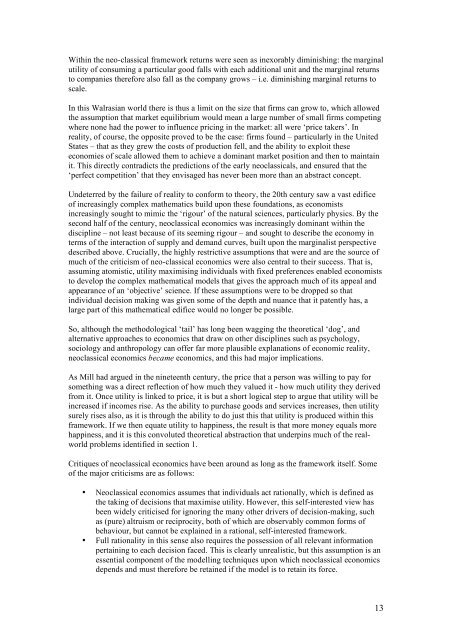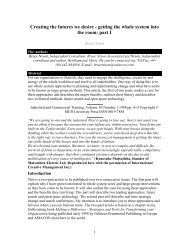From Old Economics to New Economics- Radical ... - Bruce Nixon
From Old Economics to New Economics- Radical ... - Bruce Nixon
From Old Economics to New Economics- Radical ... - Bruce Nixon
You also want an ePaper? Increase the reach of your titles
YUMPU automatically turns print PDFs into web optimized ePapers that Google loves.
Within the neo-classical framework returns were seen as inexorably diminishing: the marginal<br />
utility of consuming a particular good falls with each additional unit and the marginal returns<br />
<strong>to</strong> companies therefore also fall as the company grows – i.e. diminishing marginal returns <strong>to</strong><br />
scale.<br />
In this Walrasian world there is thus a limit on the size that firms can grow <strong>to</strong>, which allowed<br />
the assumption that market equilibrium would mean a large number of small firms competing<br />
where none had the power <strong>to</strong> influence pricing in the market: all were ‘price takers’. In<br />
reality, of course, the opposite proved <strong>to</strong> be the case: firms found – particularly in the United<br />
States – that as they grew the costs of production fell, and the ability <strong>to</strong> exploit these<br />
economies of scale allowed them <strong>to</strong> achieve a dominant market position and then <strong>to</strong> maintain<br />
it. This directly contradicts the predictions of the early neoclassicals, and ensured that the<br />
‘perfect competition’ that they envisaged has never been more than an abstract concept.<br />
Undeterred by the failure of reality <strong>to</strong> conform <strong>to</strong> theory, the 20th century saw a vast edifice<br />
of increasingly complex mathematics build upon these foundations, as economists<br />
increasingly sought <strong>to</strong> mimic the ‘rigour’ of the natural sciences, particularly physics. By the<br />
second half of the century, neoclassical economics was increasingly dominant within the<br />
discipline – not least because of its seeming rigour – and sought <strong>to</strong> describe the economy in<br />
terms of the interaction of supply and demand curves, built upon the marginalist perspective<br />
described above. Crucially, the highly restrictive assumptions that were and are the source of<br />
much of the criticism of neo-classical economics were also central <strong>to</strong> their success. That is,<br />
assuming a<strong>to</strong>mistic, utility maximising individuals with fixed preferences enabled economists<br />
<strong>to</strong> develop the complex mathematical models that gives the approach much of its appeal and<br />
appearance of an ‘objective’ science. If these assumptions were <strong>to</strong> be dropped so that<br />
individual decision making was given some of the depth and nuance that it patently has, a<br />
large part of this mathematical edifice would no longer be possible.<br />
So, although the methodological ‘tail’ has long been wagging the theoretical ‘dog’, and<br />
alternative approaches <strong>to</strong> economics that draw on other disciplines such as psychology,<br />
sociology and anthropology can offer far more plausible explanations of economic reality,<br />
neoclassical economics became economics, and this had major implications.<br />
As Mill had argued in the nineteenth century, the price that a person was willing <strong>to</strong> pay for<br />
something was a direct reflection of how much they valued it - how much utility they derived<br />
from it. Once utility is linked <strong>to</strong> price, it is but a short logical step <strong>to</strong> argue that utility will be<br />
increased if incomes rise. As the ability <strong>to</strong> purchase goods and services increases, then utility<br />
surely rises also, as it is through the ability <strong>to</strong> do just this that utility is produced within this<br />
framework. If we then equate utility <strong>to</strong> happiness, the result is that more money equals more<br />
happiness, and it is this convoluted theoretical abstraction that underpins much of the realworld<br />
problems identified in section 1.<br />
Critiques of neoclassical economics have been around as long as the framework itself. Some<br />
of the major criticisms are as follows:<br />
• Neoclassical economics assumes that individuals act rationally, which is defined as<br />
the taking of decisions that maximise utility. However, this self-interested view has<br />
been widely criticised for ignoring the many other drivers of decision-making, such<br />
as (pure) altruism or reciprocity, both of which are observably common forms of<br />
behaviour, but cannot be explained in a rational, self-interested framework.<br />
• Full rationality in this sense also requires the possession of all relevant information<br />
pertaining <strong>to</strong> each decision faced. This is clearly unrealistic, but this assumption is an<br />
essential component of the modelling techniques upon which neoclassical economics<br />
depends and must therefore be retained if the model is <strong>to</strong> retain its force.<br />
13



